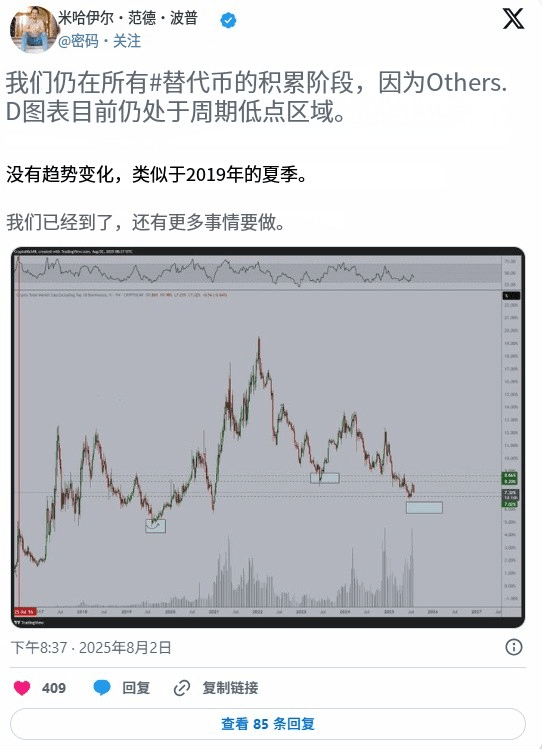
When the market is trapped in prolonged consolidation, most investors' attention to altcoins gradually cools, but this may be the most critical 'key window'—the current altcoin market exhibits multiple indicators that replicate the characteristics of historical accumulation periods, with hidden layout signals beneath the surface of boredom.
1. Signal of the cycle low: Dominance approaching historical support
The market dominance of altcoins (Others.D indicator, which refers to the market capitalization share of crypto assets outside the top ten) is currently hovering at 7.26%, slightly above the long-term support level, but close to the cycle lows of 2019 (4.25%) and 2022 (6.5%). Historical data shows that reversals after this indicator hits the bottom often trigger explosive altcoin trends: after hitting the bottom in 2019, altcoins averaged over 300% gains in the following 12 months; after the bottom rebound in 2022, some coins achieved gains of over 5 times.
This low-level hovering is not accidental; it is a typical characteristic of funds 'quietly laying out' their positions. Crypto analyst Michaël van de Poppe points out that the current market structure is very similar to that of the summer of 2019—when the Others.D indicator also hovered at a low level for several months, followed by a retreat in Bitcoin's dominance and a rotation upward in altcoins. Although there has not yet been a trend reversal signal, the 'consolidation near the cycle low' itself is a core feature of the accumulation phase.

2. Index and indicators: The 'altcoin season' that has yet to start
The altcoin season index is only 35 points: This index from CoinMarketCap needs to reach 75 points to signify the start of 'altcoin season,' while the current reading of 35 points is not only far below the peak of 87 points in December 2024 but has also further declined from last week's 43 points, clearly indicating that the market is still in 'Bitcoin season'—Bitcoin continues to outperform the vast majority of altcoins, with risk-averse sentiment dominating the market.
RSI Neutral Hovering: The Relative Strength Index (RSI) of the Others.D indicator remains stable in the neutral zone around 50, indicating neither overbought nor oversold, confirming that the market is in a state of 'sideways consolidation, lacking a trend.' This 'lack of momentum' characteristic completely aligns with the accumulation period in 2019, during which the RSI hovered in the neutral zone for nearly 6 months before breaking upward alongside an increase in trading volume.
3. Trading volume and historical mirror: waiting for 'confirmation signal'
Historical cycle experience shows that the reversal of altcoin dominance often precedes a 'trading volume peak'—in both the 2019 and 2022 bottom regions, there was a sudden increase in trading activity, marking the end of 'surrender-style sell-offs' or the rekindling of buying interest. However, the current market has not yet seen similar signals, and trading volume remains low, indicating that capital is still on the sidelines and has not formed a unified action.

However, this 'lack of confirmation' is not a bad thing. The rule in the crypto market is that true bottoms often form when the majority lose patience. The accumulation period in 2019 lasted nearly 8 months, during which market sentiment shifted from anxiety to numbness, ultimately breaking the deadlock when trading volume suddenly expanded. The current 'boring consolidation' may be replicating this process, and an 'unexpected surge' in trading volume will serve as the initiation signal.
4. Conclusion: The layout logic of 'boring moments'
The current 'boredom' in the altcoin market is essentially a necessary stage of cycle transition: Bitcoin's dominance has not retreated, trend indicators lack momentum, and trading volume has yet to confirm; these features collectively point to the 'accumulation period not yet ended.' However, historical experience also proves that the longer the consolidation time at the cycle low, the stronger the subsequent explosive momentum.
For investors, the core strategy at this time is not to blindly enter the market but to 'track signals, patiently wait':
Watch whether the Others.D indicator falls below 7%, approaching the historical strong support area of 4.25%-5%—this area is historically the 'biggest opportunity point';
Wait for the altcoin season index to stabilize above 50 points, indicating that funds are beginning to shift from Bitcoin to altcoins;
Wait for trading volume to show 'explosive breakout' and for RSI to move away from the neutral zone and head upwards, confirming the shift in momentum.
The so-called 'most boring but most important moment' refers to this stage of 'signals unclear but cycles at bottom'—although there are no immediate gains, it is the best window for selecting quality targets and formulating layout plans. When the market becomes lively again, real opportunities will have already been left for those who prepared in advance.
Wait for the market to start; we will re-enter to buy the dip, using our original: 'rolling penetration rotation strategy' to maximize participation in the entire altcoin season.


